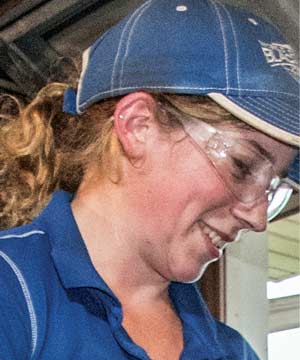If you work with a veterinary practice, you may find cases in which the veterinarian wishes for higher hoof angles for the horses. When collaborating, the team may deal with caudal heel pain, navicular syndrome on a low-heeled horse or an injury to the deep digital flexor tendon, so raising the hoof angle can become an absolute necessity.
The first step when it comes to hoof care has to be the trim. Low-angled hooves typically grow more toe than heel, often coupled with collapsed, run forward heels and minimal sole growth. This extra toe length has been shown to increase breakover time and often causes horses to place their hooves farther forward in relation to their body, leading to more overreaching in hind feet.1,2
Conventional wisdom suggests that because the horse presents extra toe and not enough heel, we should trim off as much toe as possible and leave the heel, but this can result in over-trimmed hooves that don’t have enough vertical depth and protection between the coffin bone and the ground. We could benefit from the veterinarian supplying radiographs. This can help us determine how much sole material they can safely remove.
Although removing excessive toe is important, how it’s removed is the key. If a horse is already lacking depth, the toe should be trimmed back vertically rather than horizontally. This approach protects the remaining foot, but shortens the toe lever, improves the breakover distance and brings the hoof into better proportion.
Counterintuitively, low-angled hooves may need some heel trimmed off as well. If the heel is rolled and crushed instead of being straight and strong, the crushed heel should be removed as long as there is enough hoof to safely remove it without over-trimming the hoof. Once horn tubules are kinked, they will not straighten out and new growth will often follow the old pattern. Removing the damaged hoof allows the new growth to grow straighter, provided that the cause of the crushed heels is addressed.
An often-overlooked aspect of treating the low-angled hoof is frequency of care. No matter how perfect the trim and shoeing, the low-angled hoof will grow more toe throughout the shoeing cycle, which in turn lowers the palmar angle of the coffin bone, increases stress on the deep digital flexor tendon and encourages the horse to place the limb farther forward, shifting weight-bearing farther back onto the crushed heels. The longer this scenario plays out, the more extreme the condition becomes and the more damage will be done to bone, soft tissue and hoof. One study that recorded hoof shape and hoof and pastern angles in 26 horses over a 4-month period observed that by the end of the shoeing cycle most horses had lower angles and concluded, “the results support regular (4- to 6-week) farriery intervals for the optimal prevention of excess loading of palmar limb structures, reducing long-term injury risks through cumulative, excessive loading.”3
References
- Clayton HM. (1990). The effect of an acute angulation of the hind hooves on diagonal synchrony of trotting horses. Equine Veterinary Journal. Supplement, (9), 91–94.
- Clayton HM. (1990). The effect of an acute hoof wall angulation on the stride kinematics of trotting horses. Equine Veterinary Journal. Supplement, (9), 86–90.
- Lesniak K, Williams J, Kuznik K, Douglas P. (2017). Does a 4-6 Week Shoeing Interval Promote Optimal Foot Balance in the Working Equine? Animals: an open access journal from MDPI, 7(4), 29.
Learn More
- Considerations Before Raising the Hoof Angle with an Appliance: When discussing the issue with a veterinarian, explain the pros and cons of each method before addressing.
- Are You Trimming Proper Hoof Angles?: Just as one size does not fit all, one angle does not fit all.
- The Ideal Hoof Angle Depends on the Horse: No single number should dictate how all horses are trimmed.







